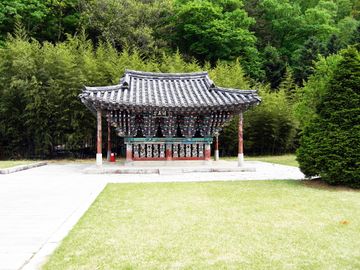의령 충의각
| 의령 충의각 Chunguigak Pavilion, Uiryeong |
|
 의령 충의각, 국가문화유산포털, 문화재청. |
|
| 대표명칭 | 의령 충의각 |
|---|---|
| 영문명칭 | Chunguigak Pavilion, Uiryeong |
| 한자 | 宜寧 忠義閣 |
| 주소 | 경상남도 의령군 의령읍 충익로 1 |
| 지정(등록) 종목 | 경상남도 문화재자료 제522호 |
| 지정(등록)일 | 2010년 12월 9일 |
| 분류 | 유적건조물/인물사건/인물기념/사우 |
| 시대 | 일제강점기 |
| 수량/면적 | 1동 |
| 웹사이트 | 의령 충의각, 국가문화유산포털, 문화재청. |
|
|
|
해설문
국문
의령 충의각은 임진왜란 당시 의병을 일으켜 나라를 구한 곽재우와 그 아래에서 활약한 17장군의 이름, 본관, 호*, 벼슬 등을 기록한 명판을 보관하고 있는 건물이다. 원래 1910년 합천이씨 문중에서 의령읍 동동리에 관찰사를 지낸 이중하를 기리는 비석을 보호하기 위해 세웠던 건물이다. 1972년에 재부산향우회에서 이를 매입하여 충익사 인근으로 옮겨왔고, 1978년에 충익사 정화사업을 하면서 지금의 자리에 위치하게 되었다.
건물은 앞면 2칸, 옆면 1칸으로 옆에서 보았을 때 여덟 팔(八)자 모양의 건물이다. 지붕 아래 목재 구조물의 높이가 매우 높고 지붕의 면적이 넓으며, 극락세계**를 바라는 상여모양을 본뜬 건물로 장식과 예술성 그리고 기술적 가치가 매우 높은 자료이다.
- 호(號): 조선시대 이름을 잘 부르지 않는 풍습에 따라 편안하게 부를 수 있도록 지은 이름
- 극락세계(極樂世界): 아미타부처님이 살고 계신 세계로, 괴로움이 없고 편안하고 자유로운 세상.
영문
Chunguigak Pavilion, Uiryeong
This pavilion holds hanging plaques that record the name, clan, pen name, and official posts of Gwak Jae-u (1552-1617), a leader of a civilian army during the Japanese invasions (1592-1598), and the 17 generals who served under him.
This building was first built in 1910 in Dongdong-ri, Uiryeong-eup, to house a stele commemorating the ancestors of the Hapcheon Yi clan. However, in 1972, the building was purchased and moved to the vicinity of Chungiksa Shrine, which commemorates Gwak Jae-u. When Chungiksa Shrine underwent a large-scale renovation in 1978, the building was again moved to its current location within the shrine complex.
This stele pavilion has a remarkably unusual design with massive brackets located under the roof to support it. The proportion of the roof support brackets compared to the roof and walls is extraordinary, and the ornateness and intricacy of the brackets exceed those found in most Buddhist temples or royal palaces. The walls feature wooden windows carved with flower designs. This strange design could intend to resemble the bier that appears in the Buddhist Paradise of the West or the wooden canopies installed inside the worship halls of Buddhist temples, or it could be that it is influenced by foreign architecture styles such as that of China.
영문 해설 내용
임진왜란 때의 의병장인 곽재우(1552-1617)와 그 아래에서 활약한 장군 17명의 이름, 본관, 호, 벼슬 등을 기록한 명판을 보관하고 있는 건물이다.
원래 합천이씨 문중에서 선조를 기리는 비석을 보호하기 위해 1910년 의령읍 동동리에 세웠던 건물이다. 1972년 건물을 매입하여 곽재우를 기리는 사당인 충익사 인근으로 옮겨왔고, 1978년 충익사 정비사업을 하면서 지금의 자리에 위치하게 되었다.
이 건물은 일반적인 비각과는 다른 특이한 모습을 하고 있다. 지붕과 벽의 높이에 비해 지붕을 받치고 있는 나무구조물의 높이가 매우 높고, 사찰이나 궁궐 건물보다도 더 다양하고 화려한 조각들로 장식되어 있다. 그 아래의 벽은 앞면에는 네 면에 꽃을 새긴 살창을 달았다. 극락세계를 나타내는 상여나 사찰의 법당에서 불상 위에 설치하는 닫집의 모양을 본뜬 것으로 보이며, 또는 중국 등 외래 건축의 영향을 받은 것으로 보인다.